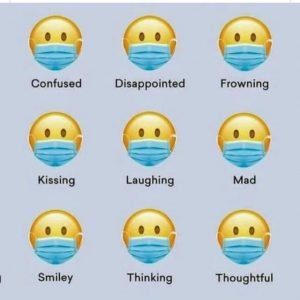Professional Register of
Traditional Chinese Medicine

Picture: Different expressions of people wearing a mask.
by Sonniva Dawson, a member of the PRTCM who is a practitioner of Traditional Chinese Medicine (TCM) using Acupuncture and Chinese Herbal Medicine.
I would like to say something here about how the Sìzhěn (the Four Diagnostic Methods of Traditional Chinese Medicine) have been impacted in my clinic by compulsory wearing of a mask by practitioner and client.
Wènzhěn (Asking Diagnosis)
For new clients it can be quite daunting to form a relationship with me if they cannot see my face, questions and answers can get lost without accompanying facial expressions. Are they smiling, frowning or stony faced beneath the mask? Does the question asked make sense to the client when they cannot see my face? I must choose my words carefully, asking precise clearly directed questions and make it as easy as possible for the client to understand and therefore give me a relevant answer.
Wàngzhěn/Wàngshě (Looking Diagnosis)
Looking at the client, observing their movements, generally has not changed, but observation of the face has been severely curtailed. The colour of the face, which may change during the consultation, its distribution around the mouth, cheeks, under the eyes, colour of the lips, the condition of the teeth, facial lines, scars and all the stories a face can tell, which in normal times can be observed at leisure during Wènzhěn, are now confined to inspection while the client briefly removes their mask during Wàngshě / tongue inspection. This means absorbing and noting all the relevant information in a much shorter period of time. Changes in the client’s face post treatment are not as easily seen. Practise, practise, practise.
Wénzhěn (Listening Diagnosis)
Listening is so much more than hearing words clearly. The tone of the voice can be distorted by the mask, listening to specific sounds emitted by the client is harder to judge and is laboured breathing due to the density of the fabric of the mask? Is the sigh always there or is it just frustration at trying to converse with someone through masks? Are they shouting to make themselves heard? These are consequences of wearing a mask. I have to re-adjust and fine tune my listening skills, as I get more accustomed to listening while someone is speaking with a mask, for the sounds I hear to be more easily interpreted. But on initial consultation it can be difficult.
Smell is also an important part of Sìzhěn, hugely disrupted by wearing a face mask. In normal times various odours are easily observed during a consultation. Mostly noticeable when returning to consultation room and removing acupuncture needles, I am lucky to have the required 2 meter distance from door to couch so I overcome this obstacle by delaying putting on my mask for a few seconds while keeping the required distance from the client, this gives just enough time to observe the smell (if any) in the treatment room.
Qiēzhěn /Qiēmài (Tongue and Pulse Diagnosis)
Touching and Pulse examination have not been hugely impacted by wearing a face mask, but the length of time in close physical contact has to be been curtailed. It is vital that a thorough examination is carried out where necessary, but it must be done in a timely fashion, no corners cut and no unnecessary delays either, and hands sanitized following patient contact.
This is just a short note on observations from my own clinic.
For questions or comments, you can reach us through our Contact Us page.